Murder! Murder! Starbucks quietly murders the earth with 4 billion takeout cups every year!
For professional baristas, please follow the coffee workshop (Wechat official account cafe_style)
Each year, Starbucks provides customers with 4 billion disposable paper cups.
One of them may be one of your drinks. Or dozens of cups.
But have you ever thought...
Where did all these cups end up?
"some things are not what you think." Shiloh Britt said to the Silicon Man.
She worked in a Starbucks coffee shop in Seattle for four years. Her position is known as a "Partner", which is what Starbucks calls all store employees who work more than 20 hours a week. As a partner, she gets a variety of Medicare benefits and some Starbucks stock.
But that doesn't mean Britt has any decisions or voting rights on major corporate matters-in fact, her authority is so low that she can't even control the size of her own store.
For example, how to deal with hundreds of kilograms of rubbish in the store every day.
A few Starbucks stores classify waste as "Recycle", "Compost" and "Trash". But Britt found it useless because consumers had no idea which grid to throw their trash into.
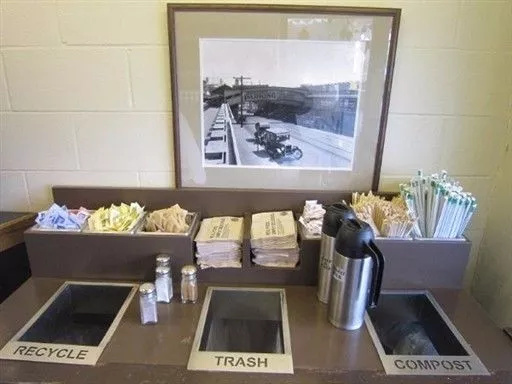
At the end of the day, garbage bags from different categories were disposed of in the same way.
"Why are you doing this?" It's not that she hasn't asked the manager, but she can't get an answer.
Starbucks is the world's well-known fast-food chain with more than 26000 stores and is popular with consumers in the two major markets in China and the United States.
For Starbucks, providing qualified drinks and convenient and friendly store experience is the foundation of the company. But at the same time, Starbucks has always seen itself as a global leader in providing catering services in sustainable solutions, a green company, like its trademark and theme color.
It claims to minimize the impact on the environment in its operations, such as recycling waste from stores in an environmentally friendly way.
The real situation is: different categories are treated uniformly, some of them are the same plastic bag in different categories, or they are clearly divided into boxes but not marked for classification:
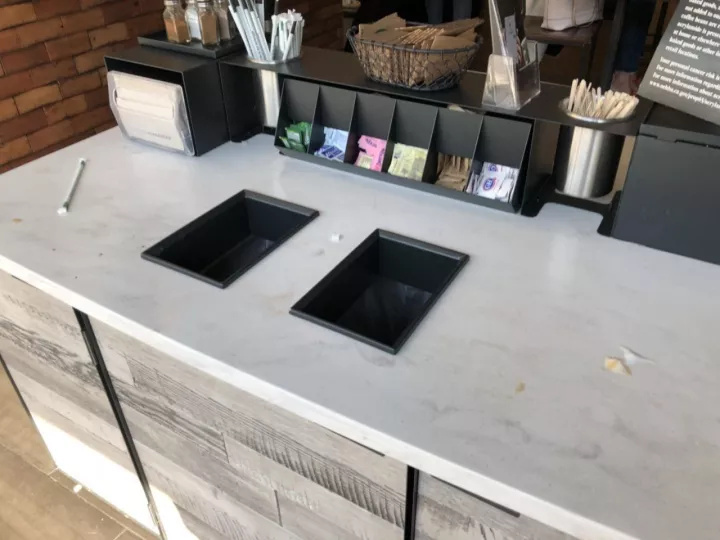
As a result, Starbucks stores fill garbage bags with almost the same thing at the end of the day, classified or not: straws, straw wrappers, plastic cups, paper cups, hot cup holders and various mixtures of unfinished drinks.
Don't believe it? Visit Starbucks nearest to you now and see what the situation is like. It will certainly surprise you.
Many Starbucks baristas interviewed face-to-face and remotely complain to varying degrees about the way the company disposes of garbage.
In fact, the real problem behind Starbucks garbage sorting is that what it calls recyclable paper cups can't really be done in practice.
Starbucks, which shows people with the image of environmental protection and social responsibility, has a side that you can't see beneath its glossy appearance.
Fifty years ago, Neil Armstrong and Buzz Aldrin landed on the moon on Apollo 11.
Fifty years later, we still haven't finished with these little paper cups.
Starbucks supplies about 4 billion paper cups to customers each year, according to Stand.earth, an environmental charity.
On the paper cup, you will find this line of small print:
This paper cup is made of 10% recycled fiber after consumption. It cannot be heated by microwave.
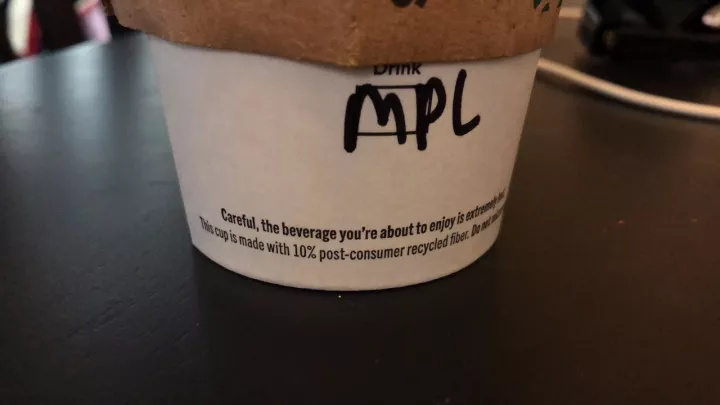
The reason for "not microwave heating" lies in another important component of the paper cup: polyethylene (PE) water resistant coating on the inner wall.
Polyethylene is a polymer material, containers, plastic bags, plastic films and other packaging materials are made of it. It is quite high pollution, but fortunately the corresponding recycling technology has been relatively advanced, and waste paper recycling paper, in theory,"polyethylene can also be recycled."
Ideal is beautiful, but reality is very skinny. In fact, polyethylene recycling technology is not popular in the market, and there are very few waste paper factories with recycling capacity. Most recycled paper mills have equipment that can't separate the coating from the paper cups, and forcing it will clog the equipment.
According to a report by the Sustainable Packaging Coalition, the number of non-paper recycling plants in the United States that can recycle paper cups is limited, serving only 20% of the population. Stand.earth also found that only 18 of the top 100 cities in the United States have environmental departments that recycle paper cups. Jason Pelz, vice president of the Cardboard Association, another industry group, points out that there are more than 450 recycling plants in the United States, and less than 1% of capacity can recycle plastic-coated paper.
When Starbucks tells you that paper cups are 100 percent recyclable, what it doesn't tell you is the embarrassing truth that no factory can accept them.
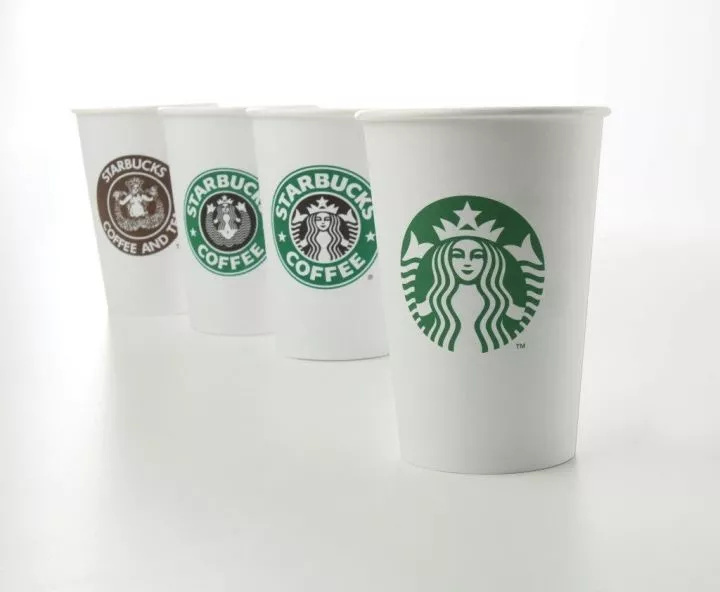
The environmental harm of paper cups does not begin after consumption. It has become a serious source of greenhouse gases before consumption.
Remember the small print on the paper cup? "10% recycled fiber after consumption".
This is a foreign term for recycled paper, which means that 90% of paper cups come from logs and 10% from recycled materials.
"Paper cups are our logo, our advertising is an important part of the social trend that Starbucks represents," Jim Hanna, a former director of environmental affairs at Starbucks, told Express in 2010.
Starbucks' most recognizable product has never been coffee or anything, but the iconic paper cup.
To maintain this mark, 1.6 million trees are cut down, chopped, cooked and pulped at high temperature and high pressure every year.
According to the United Nations Environment Programme and the Intergovernmental Panel on Climate change, the greenhouse gas emissions from making these disposable paper cups are equivalent to the emissions of 30,000 cars driving for a whole year.
After one-time use, almost all the paper cups are discarded and degraded. However, this process produces large amounts of methane, another common greenhouse gas.
Every cup of coffee you drink is a small production machine of Greenhouse Effect; every disposable paper cup you throw away is killing the earth.
Starbucks remains indifferent.
Starbucks disposable paper cup waste is not only shipped to landfills in the United States, but also "exported" to China.
Sheraton Seattle Hotel, October 10, 2017. This morning Starbucks CEO Kevin Johnson (Kevin Johnson) is here to share Starbucks' progress in marketing and technology research and development.
Demonstrators in Stand.earth took up space in front of the hotel early in the morning.
Behind them is a huge sculpture of Starbucks Paper Cup Monster. The monster has a wingspan of 15 feet, blocking almost the entire sidewalk. It is made up of hundreds of discarded Starbucks paper cups, which took several weeks to collect and more than a month to make.
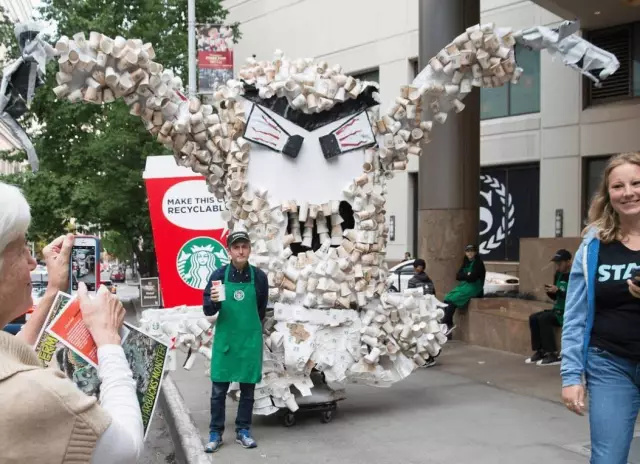
Most of the demonstrators had their own jobs, including music producers, pupils and employees who had worked at Starbucks for many years. But after all, the famous WTO demonstration 20 years ago took place in Seattle, where the proportion of the population that is passionate about environmentalism is among the highest in the United States, and everyone is a professional environmentalist, and this group is no exception.
They wore the signature green aprons of Starbucks baristas and black Starbucks hats. They have smiles on their faces, just like the smiles you see on the faces of Starbucks baristas.
They distribute stickers, leaflets and cartoons featuring mermaids to passers-by. It was only after reading the materials carefully or talking to them for a few minutes that people realized that these people were not employees of Starbucks.
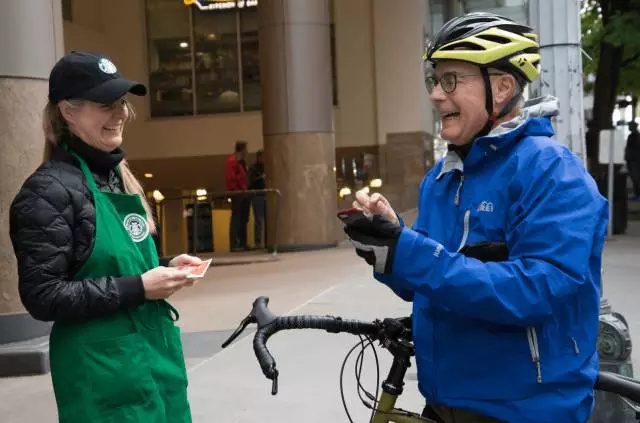
Demonstrators told the Silicon Star that if Johnson, a Microsoft executive, is serious about turning Starbucks into a technology and experience first company, he must first solve the company's biggest environmental problem: 4 billion paper cups that cannot be recycled.
And most of these discarded Starbucks disposable paper cups ended up in landfills.
Seattle is one of the few cities in the United States with the recycling capacity of polyethylene-coated paper cups, but Starbucks still relies heavily on landfills in its stronghold.
Driving north from Seattle is about an hour's drive to a special waste disposal plant, where facilities use organic technology to degrade waste. The treatment rooms are covered with thick waterproof cloth, like a greenhouse, where bacteria erode the sorted garbage, emitting extremely high temperatures and a special smell.
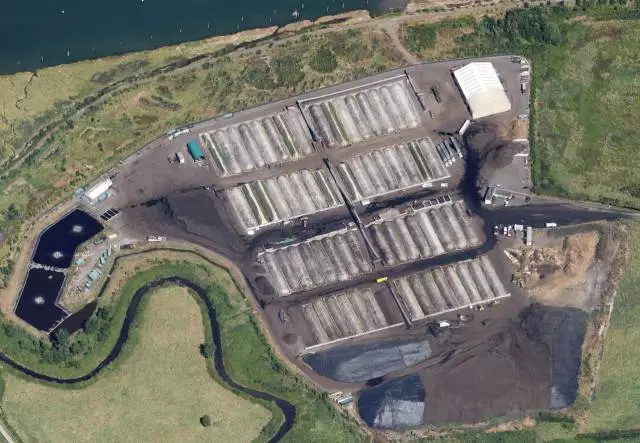
It is owned by Hidagrov Landfill Industry, a professional garbage company that operates a full-process business ranging from recycling and remanufacturing to wholesale and retail. A certain proportion of Starbucks' waste comes to the factory, where scraps of food from paper cups, cardboard boxes and discarded napkins are degraded by bacteria to make a popular commodity for consumers: soil or fertilizer for planting.
But that still doesn't meet the needs of Starbucks, which produces too much garbage every day-- many of which lack reasonable classification.
As a result, a large number of paper cups are sent to local landfills in Washington state, or to ordinary landfills in southern Oregon, packed in air-insulated bags, buried underground and forgotten forever.
Or there is another way out:
Together with garbage such as packing boxes, it is exported to waste paper factories in China in the name of waste paper or mixed waste.
Yes, China is the world's largest importer of garbage.
Starbucks' international trade in waste creates problems in both countries: China's recycled paper recycling process and production capacity are slightly better than those in the United States, but after all, China is Starbucks' second largest and fastest-growing market. The local recycled paper industry has received a lot of Starbucks waste.
China has long suffered from white pollution and is fed up with the import of foreign rubbish. In 2013, Chinese regulators launched a "hedgerow" campaign to restrict garbage imports, especially garbage smuggling, a program that continues to this day.
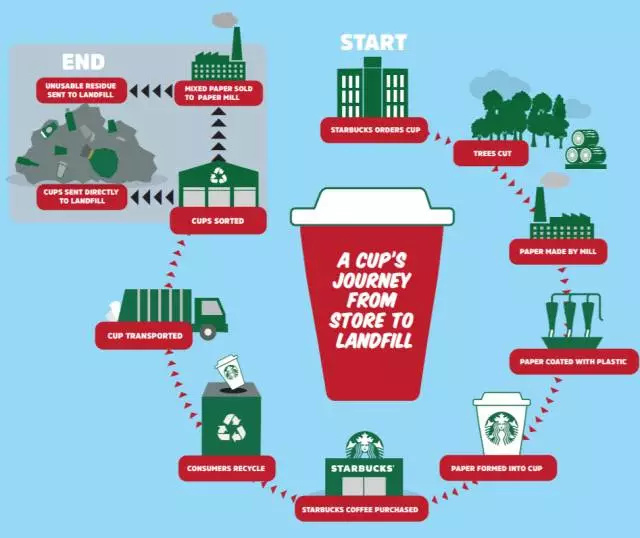
The Life of Starbucks Paper Cup
Jim Ace, Stand.earth project manager, pointed out to Silicon that China's restrictions on the import of waste paper, scrap metal and other foreign waste will indirectly lead Starbucks to increase its landfills in the United States.
This obviously runs counter to Starbucks' image of "attaching importance to environmental protection".
As a result, the company had to prevaricate with words such as complexity, huge challenges, and throwing the pot at its partners. Starbucks operates in 75 countries and the situation is complicated, according to its website. And in the vast majority of stores, the way of waste disposal, whether to recycle, how to recycle, is usually decided by the property.
What's more, all the above is just the garbage that Starbucks can collect in its stores. Most people bring paper cups back to their offices, homes, shopping malls and more, where there is usually no garbage sorting at all, further complicating the whereabouts of paper cups and causing more pollution.
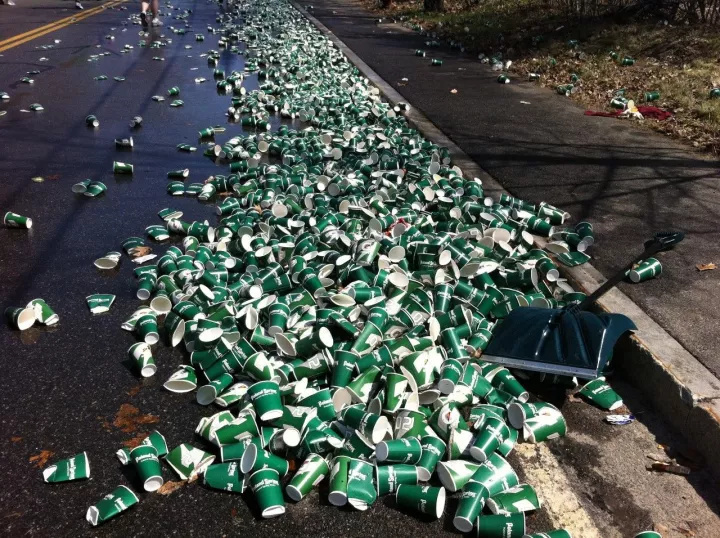
In the face of huge commercial profits, Starbucks "conceded defeat" again and again.
4 billion disposable paper cups, carrying a lot of polyethylene that has been difficult to degrade for centuries, went to landfills around the world and became a gift from Starbucks to nature.
No one wants the gift.
In 2008, environmentalists in Seattle denounced Starbucks, accusing it of not only destroying forests, but also producing large amounts of unrecyclable waste that continued to pollute the planet.
Starbucks has been affected by the financial tsunami, and fell into a serious public relations crisis.
In an effort to quell anger, Starbucks promised to make all paper cups 100 per cent recyclable within seven years and to implement an incentive scheme for 1/4 consumers to bring their own coffee cups.
It has also entered into a partnership with the Massachusetts Institute of Technology to develop new paper cup recycling technology, held three more "paper cup summits" and held discussions with the industry, hoping to work out a comprehensive recycling plan.
However, before the seven-year deadline, Starbucks said in its corporate responsibility report in 2013 that it could not find a solution.
At the same time as it threw in the towel, the company also reduced its commitment to encourage the consumption of its own coffee cups from 25% to 5%.
Because if you don't cut yourself, the promise will never be fulfilled, not to mention 2015. Starbucks, the leader in the global fast-consuming beverage chain, is stretched by its promises.
Starbucks offers discounts to consumers to encourage them to use their own cups. In China, it costs 2 yuan to bring a cup to the store, while in the United States, the discount is 10 cents.
In the field of behavioral psychology, this kind of reward is called "positive motivation". It helps consumers to remember in the short term, but it is not the most effective incentive. What corresponds to positive motivation is negative motivation, that is, punishment. One possible way: use disposable paper cups for coffee, which is 2 yuan more expensive than the normal price.
Starbucks' average unit price is 30 to 40 yuan, or about $4 to $5. 2 yuan or 10 cents is not a particularly large increase, but it is still enough to compare the original price with the original price in the minds of price-sensitive consumers. Studies have generally shown that punishment is more effective than encouragement and is more likely to form habits.
In 2016, after several failed demonstrations at Starbucks headquarters, Stand.earth members were finally able to meet with company executives. They brought these behavioral and psychological research results, but unfortunately Starbucks could not adopt them.
The reason is that Starbucks attaches great importance to the customer experience in the store, and the price increase will give consumers the impression that "the store does not welcome me" and "does not want to do business." Punish users for fundamentally violating Starbucks settings. Not to mention Starbucks, I'm afraid no company wants to do business like this.
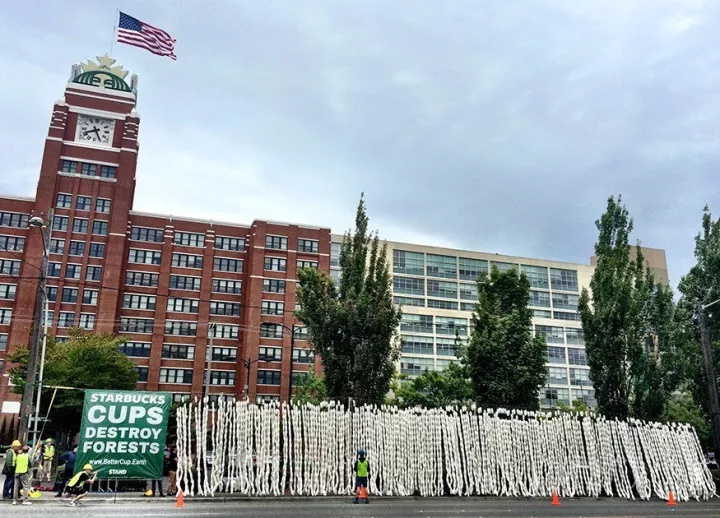
Demonstrators hang "paper cup walls" outside Starbucks headquarters
If negative motivation doesn't work, positive motivation.
The truth is, Starbucks doesn't have a strong promotion of bringing its own cups on sale at all. In China and the United States, there is no open and obvious material in the store to inform customers; in the United States, if customers do not confirm with baristas, baristas will not take the initiative to inform customers and reduce prices.
It is more like an urban legend than a Starbucks official environmental measure to reduce the price of bring your own cup.
It is only on a few specific days, such as Earth Day on April 22 this year, that Starbucks offers a free drink with its own cup. Then, as usual, the incentive to bring your own cup on sale was in vain.
In 2014, Starbucks customers used their own coffee cups 1.7% of the time. By 2015, the proportion had fallen instead of rising, to 1.6%, or about 4450 times.
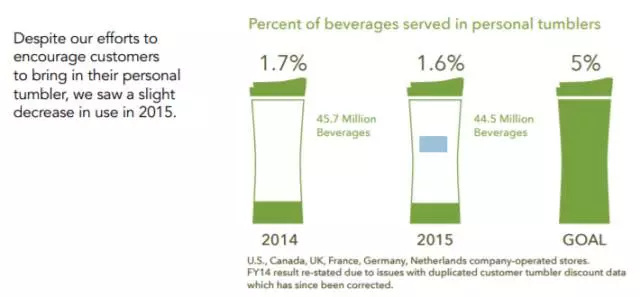
By doing some simple arithmetic, you can understand Starbucks' mental process of passively promoting bring-yourself cups:
4 billion paper cups per year, which translates to 4 billion person-times temporarily. According to the promise made by Starbucks in 2008, the proportion of customers who bring their own cups will reach 25%, or 1 billion, with a price reduction of 10 cents per person. Finally, the price reduction of bring-your-own cups will lead to a loss of $100 million in annual revenue.
Starbucks had revenue of $19.15 billion in fiscal 2015, or about 5 per thousand of $100m.
That doesn't count the marketing budget. If Starbucks really wants to increase the proportion of its own cup consumption from a pitiful single digit to 25%, it will have to pay huge promotional fees to buy televisions, outdoor and social media advertisements, and so on. the annual cost may be tens of millions or even hundreds of millions of dollars. Starbucks allows this system to exist, and the total cost may reach or even exceed 1% of revenue.
For companies with tens of billions of dollars in annual revenue, 1% is a lot of money.
"Starbucks is not willing to bear this loss for the sake of environmental protection. I really don't know why." One of the demonstrators interviewed said.
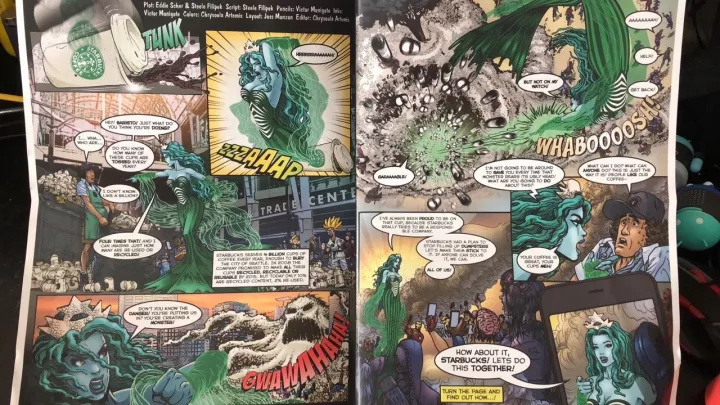
Demonstrators make "Super Mermaid vs Starbucks Paper Cup Monster" cartoon
Starbucks serves 21st century coffee in 20th century cups
The symptoms need to be cured.
Environmentalists have long helped Starbucks think of a solution: why not use a cleaner, more recyclable coating than PE to solve the problem once and for all?
This is what Stand.earth has been urging Starbucks to do. Members of the group hope Starbucks will get a better version of what they call "Cup 2.0," a disposable cup.
Demonstrators told the Silicon people that they had only three demands for Starbucks: to use 100% recycled paper cups under existing conditions, to increase the proportion of recycled contents in paper cups to 25%, and to increase the proportion of self-contained cups to 25%.
The request is not irrelevant. Companies have developed a variety of alternatives in both water and mineral-based directions. Water-based coatings dissolve more easily, and mineral-based coatings can be crushed and sifted out with other contaminants during processing. Industry insiders point out that at least one of them has a production cost equivalent to or lower than polyethylene.
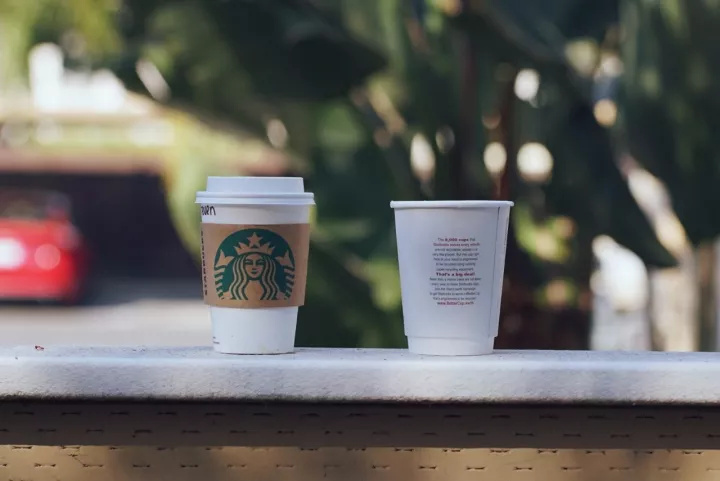
And Starbucks already has a new alternative to polyethylene coating: polylactic acid, or PLA for short. This is a substitute plastic material, the raw material is nothing else, it is the highest yield crop in the United States-corn.
Polylactic acid is often made into surgical suture, bone plate bone nail, because its degradability is very good, the earliest half a year can be hydrolyzed into lactic acid, it can be said to be very clean. At first, the counterfeiting of polylactic acid was higher, but then gradually decreased with the popularity.
Last year, Starbucks tested polylactic acid coated paper cups in a handful of stores in the UK. Oddly enough, nothing happened after this test, and Starbucks stores are still using old PE-coated disposable paper cups.
"Starbucks serves 21st-century coffee, but it uses 20th-century cups." Ace told the Silicon people.
A report provided by Starbucks explains why they are not popularizing the use of new paper cups:
Since the vast majority of consumers throw away their cups outside the store, we think the biggest change is to provide a recyclable solution and encourage users to use their own cups or in-store porcelain cups.

First of all, encouraging users to use their own cups has been answered, and Starbucks is very negative about promoting it; second, baristas also do not actively recommend customers to use in-store porcelain cups, because that will increase their cleaning workload; finally, what is "a recyclable solution"?
In fact, this is Starbucks' most frequent use of corporate rhetoric on paper cups. It means:
Instead of replacing all the PE cups once and for all, take your time, open more stores in recyclable areas, and work with recycling plants to gradually replace them with machines that can handle PE. Only in this way can we form a synergistic effect and there is a solution for overall vision.
This made Ace feel very confused, even a little angry: "Why is Starbucks doing this?" Why doesn't it start solving problems from within? Isn't that the other way around? "
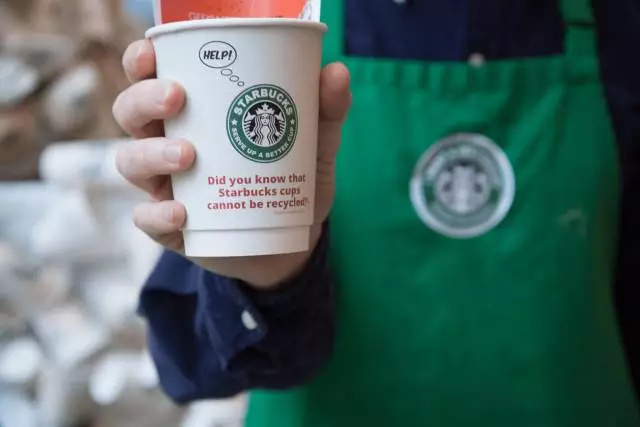
In 2010, Starbucks made it clear in its annual report on social responsibility that the company intended to solve the problem of paper cups, but it was in an environment where innovation in the recycling industry was difficult to count on.
In other words, Starbucks fully understood the real cause of the paper cup problem at least seven years ago.
However, seven years later, Starbucks is still resolutely on this old road.
Like bringing your own cup, all Starbucks' decisions depend on the abacus.
Anyone who knows anything about manufacturing knows that proofing is expensive and mass production is cheap. The less the output, the more expensive it is, and the more it produces, the cheaper it is. New orders are expensive, and the longer the two sides cooperate, the cheaper it will be.
Starbucks buys an astonishing number of paper cups at one time, and the number of an order may far exceed the 4 billion Starbucks uses each year. The larger the order, the more favorable the price. Starbucks has signed long-term contracts with its suppliers International Paper and Parker to buy enough PE-coated cups for years or even decades, according to people familiar with the matter.
If Starbucks decides to completely replace the PLA or other cleaner / recycling-friendly coatings, it will have to resign contracts with suppliers, which will significantly increase its procurement costs.
First of all, the price of the new contract will only be higher than that of the old one. Secondly, will the old contract continue to be performed? If the contract is fulfilled, Starbucks will have to continue to pay for the purchase and receive old cups that cannot be used; if it fails to do so, it will have to pay liquidated damages.
The angels of environmental protection and the demons of interests have fought a protracted battle above the top of Starbucks.
The demon wins in the end.
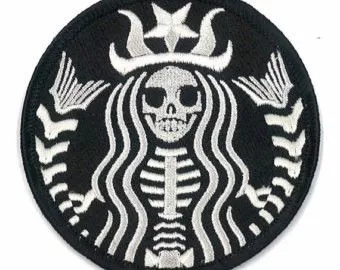
Paper cups have become Starbucks' biggest burden on environmental issues.
The assessment was made not by environmentalists and critics, but by Hannah, a former director of environmental affairs at Starbucks.
In 2014, Hanna's colleague, Ben Packard, who had been in charge of environmental affairs at Starbucks for 15 years, resigned and joined a non-profit organization. In 2016, Hannah moved to Microsoft to take charge of sustainability in the data center, along with Sue Long, a 20-year Starbucks veteran and former environmental manager.
When they joined the job, they were moved by Starbucks' focus on sustainability. During their tenure, they pushed Starbucks to use PE paper cups, a product popular with environmentalists at the time. When new problems arise and the mission of PE paper cups is coming to an end and should be replaced by new technologies, they feel powerless.
The Financial Times wrote a story about Parker's departure-a sign of the importance of Starbucks' environmental affairs division.
So far, however, the position in the department is still vacant.
Since 2008, Starbucks has made many promises, none of which has been fulfilled. That year, Starbucks predecessor CEO Howard Schultz (Howard Schultz) personally announced at a staff meeting in New Orleans that paper cups must be "100% recyclable" by 2012.
As we all know, Schultz gave Johnson the position of CEO in 2016 and became chairman himself.
In April this year, the company renewed its commitment. This time the deadline is pushed to 2022, five years later:
1) double the recyclable content used in the production of hot cups (paper cups) (from 10% to 20%) and change the material of ice cups (now polypropylene PP)
2) double the number of stores with access to paper cup recycling capacity
3) actively promote the reduction of self-brought cups and the use of porcelain cups in stores.
However, there is no dedicated person, lack of corporate governance on environmental issues, and management cares too much about every interest. The chances of a complete solution to Starbucks' environmental problems will only be slimmer.
Important Notice :
前街咖啡 FrontStreet Coffee has moved to new addredd:
FrontStreet Coffee Address: 315,Donghua East Road,GuangZhou
Tel:020 38364473
- Prev
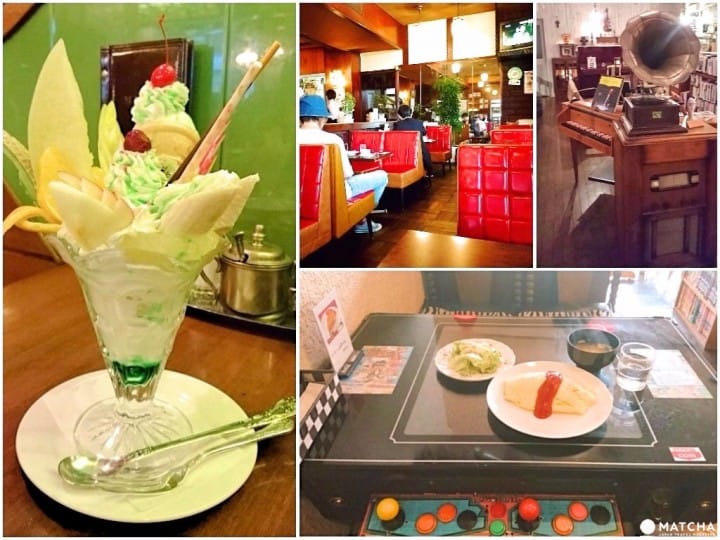
A coffee shop traveling through time and space! The characteristics of Japanese tea shop are declassified
Professional baristas Please follow the Coffee Workshop (official Wechat account cafe_style) when you come to Japan, have you noticed some inconspicuous or anachronistic cafes on the street corner? These old cafes are usually called "tea". They are like the "ice rooms" unique to Hong Kong that sell cold drinks and ice products. They are places where people can sit down and have tea and chat and relax. In the company
- Next

POST COFFEE Old Cafe has its own meaning.
Professional barista communication please follow the coffee workshop (Wechat official account cafe_style) in POST COFFEE can stay until 12:00 midnight. (photo by Liu Shih-chia) when it comes to "POST COFFEE", it should be known to experienced coffee lovers, and they must know a few things: besides the delicious coffee and the straightforward personality of the boss, brother Quan, the other is the solid milk foam of real kung fu. Say from
Related
- What documents do you need to go through to open a coffee shop? coffee shop coffee shop certificate processing process
- How to purchase Coffee beans in small Cafe how to choose a suitable supplier for domestic Coffee supply Company
- How to drink Starbucks Fragrance White Coffee? how to make Australian White Coffee? what Italian coffee beans are recommended?
- The Story of Flora Coffee: the name of Flora Coffee Bean and the implication of the Flowers on Florna Coffee
- How much does a cup of coffee cost? How much is the profit of a cup of coffee? What is the profit of the coffee shop in a year?
- Yunnan small Coffee, known as "fragrant Coffee", introduces the characteristics of Alpine Arabica Coffee producing areas in Yunnan, China
- 2023 latest Starbucks full menu price list how much is a cup of Starbucks coffee what is better to drink the most popular hot and cold drinks recommended
- Starbucks different kinds of Coffee Price list Starbucks menu 2023 Top Ten Best drinks in Starbucks
- Starbucks Spring praise Comprehensive matching Coffee Bean theme Story Packaging implication and taste description
- The cost of a cup of coffee latte American coffee cost price and selling price

